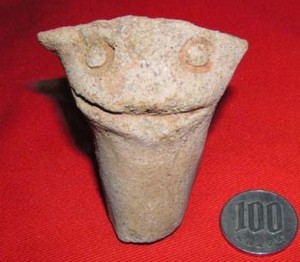 Archaeologists in the town of Umi in Fukuoka prefecture have excavated a piece of earthenware shaped as the head of a creature with googly eyes and a big grin. Opinions are divided about whether this artifact, which was unearthed from a site dating back to the Muromachi period (1336 to 1573 AD), is supposed to represent the head of a demon, dragon, snake or kappa.
Archaeologists in the town of Umi in Fukuoka prefecture have excavated a piece of earthenware shaped as the head of a creature with googly eyes and a big grin. Opinions are divided about whether this artifact, which was unearthed from a site dating back to the Muromachi period (1336 to 1573 AD), is supposed to represent the head of a demon, dragon, snake or kappa.
Kappa are mythical (or real, according to some) creatures that live in Japanese rivers and ponds. Known as pranksters, kappa are notorious for luring people (particularly small children) into water and drowning them. They also like to eat cucumbers. Some theories suggest that the word kappa comes from the Portuguese capa, which refers to the "robe" worn by Portuguese monks who came to Japan in the 16th century. The kappa's hairstyle also resembles the tonsured hair of the monks. (Further reading: Wikipedia entry for kappa.)
The artifact, which is now on display at Umi Museum, measures 5.4 cm (2 in.) tall and is believed to be one of the feet of a larger earthenware vessel. It appears that a sharp bamboo implement was used to shape the eyes and mouth.
"If this is a kappa," says museum director Koji Hiranouchi, "it is a very old representation. The craftsman was probably playing around when he made it."
Others believe the artifact is supposed to represent some sort of reptile or amphibian.
[Source: Iza!]
==========
If you ever decide to keep a kappa as a pet, check out the indispensable Kappa no Kaikata (How to Raise a Kappa), a 26-part series of animated shorts on Animax, with English subtitles (viewable on YouTube). These videos will help you avoid some of the pitfalls of raising a kappa. For example, the first episode shows the disastrous effects of what happens when you feed kappa-maki (cucumber sushi rolls) to your kappa. Evidently, wasabi disagrees with its digestive system.

Tim
I've been to Kappabashi in Kamikochi at the foot of Mt. Yarigatake. It's a beautiful spot, the initial setting for Ryunosuke Akutagawa's 1927 novel "Kappa." Great for cross-coutnry skiing in winter, though you have to hike in. Local merchants sell bits of worn glass called "kappa tears." You can almost hear the little imps in the Azusa River!
[]mrsaturn
I'm afraid the archaeologists that made this discovery are mistaken. This artifact is not the head of a Kappa, nor that of a demon, dragon or snake. Rather, it appears to be the fossilized remains of Olly, famed sock puppet co-host of The Sifl & Olly Show that ran on MTV from 1997 to 1999. For more information on Olly, as well as a picture of him with his pal Sifl (Olly is the light-skinned one), check out http://en.wikipedia.org/wiki/Sifl_and_Olly
[]Master Shake
It's friggin Master Shake!!!
[]hairyoger
Perhaps this is just the fact that I'm not an archaeologist showing. This really looks to me like something the village potter's 2 year old son made, and dad just decided to keep it.
[]